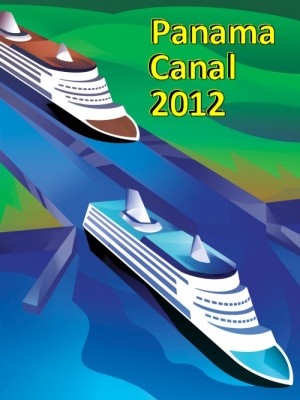 |
Creating the Canal 1
THE LOCKS and THE
HISTORY OF THE AMERICAN EFFORT
Written by Rick Archer
October 2011
|
|
Lake Gatun rests at 85 feet above
sea level. The purpose
of the locks at either end of the Canal is to lift
a ship in stages up to the Lake at 85 feet or to lower
a
ship back down to sea level.
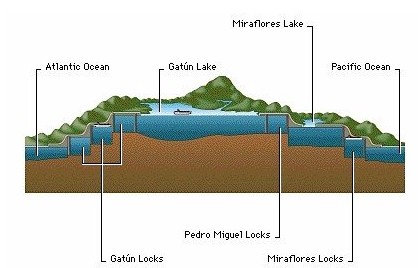
These locks
were one of the greatest
engineering works ever to be undertaken at the time.
Not until Hoover Dam did America undertake another project even
remotely approaching the Panama Canal.
|
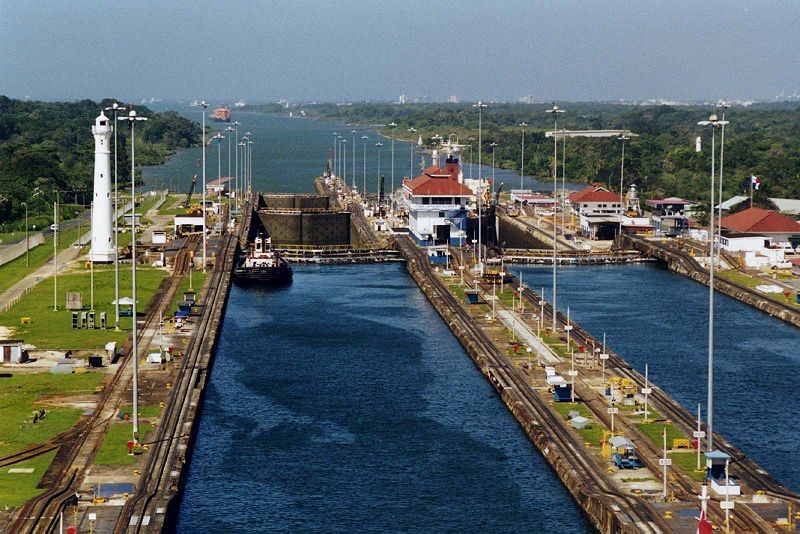 |
|
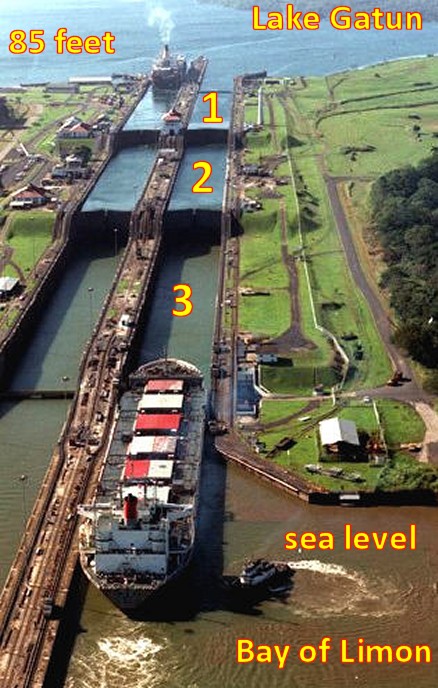
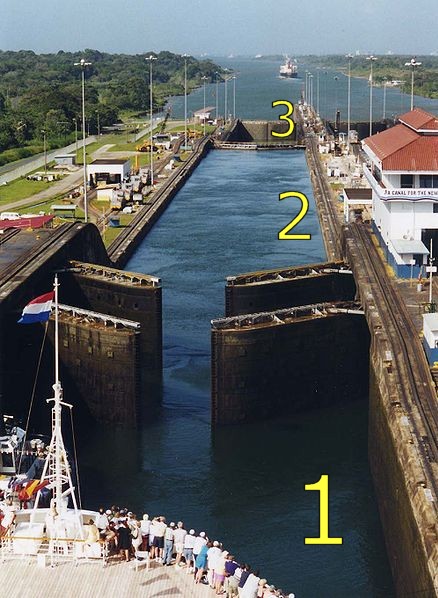 |
So how
do these locks work?
Back when you were a kid and you
played in the bathtub with toy boats, you
may remember your toy boats rose as the tub
filled with water and dropped when the water
drained. The ships in the Canal
may be very large ships, but they rise and
fall
exactly the same way. The locks
operate as giant bathtubs.
If you fill the chamber with water, the ship
automatically begins to rise. Or if
you drain the chamber, the boat will slowly
sink. It is all done by gravity.
Gravity makes the water drain.
No water in the canal is ever pumped
upwards.
The important rule is that
water seeks its own level. When the
water from one chamber is allowed to drain
into a lower chamber, gravity guarantees the
water will keep flowing until the water
level in both chambers is equal.
Then the water stops flowing of its own
accord.
There are drainage pipes inside
the concrete walls known as "culverts".
When these culverts are opened, water will
automatically drain out of the higher water
level to the lower water level until the
levels are EQUAL. A ship will
automatically rise or sink depending on
which chamber it is in. Once the water
level is equal in the two adjacent chambers,
the ship is free to float across to the next
chamber.
You may have noticed the ships barely fit
inside the water chambers. This is
deliberate. The more snugly the ship
fits in
the chamber, the less water is needed to
fill the chamber. Water is a valuable
resource here. Why waste it?
The limit to the size of a ship that can fit through the
Panama Canal is called "Panamax". In
the past 100 years, many ships have been
built that are simply too large to fit.
With this in mind, new locks are being built
right now that will be able to accommodate many of the
larger ships.
It looks like
there is no room, but there is
actually several feet of water on
either side of the ship inside the
chambers. To
keep the ships from scraping against
the walls, tugging devices known as
"mules" run on train tracks on both
sides of the ship.
These small trains
have steel cables attached to the
ship. The ship moves forward under
its own power, but the mules
guarantee the ship stays centered.
|
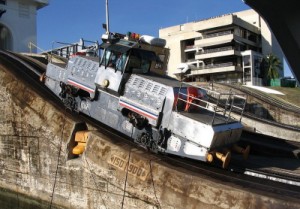 |
The lifting or lowering process is done in 3
stages on both ends of the canal. 85
feet is too much to do at one time.
The weight of the water would cause
unimaginable pressure against the iron
gates. By using three
stages to lower or raise a
ship, the combined weight of the ship and the water
is sufficiently reduced so there won't be too
much pressure on the steel doors.
This picture shows two sets of iron water
gates. The "double door" system
is used so if a runaway ship smashes against one set
of doors, the other set will still be able
to control the waters from breaking loose.
So far it has never happened, but it is a
good safety feature nevertheless.
Lowering a
Ship
Lowering a ship is easier to understand than
raising a ship. In the picture, a cruise ship is headed out to
the Bay of Limon. Chamber 1
has just drained down to the level of Chamber 2.
Since the water levels between Chamber 1 and
Chamber 2 are equal, the iron gates open to permit the ship to
slide forward into Chamber 2. Once the ship
is in Chamber 2, those same gates will close
behind the ship.
Chamber 3 up ahead appears empty. Once the
ship has moved completely into Chamber 2, the waters in Chamber 2 will
drain down into Chamber 3. The ship will
sink in Chamber 2 until the waters become equal.
Then it will float into Chamber 3.
Chamber 3 will then sink to match the sea level
to
allow the ship to leave.
Pretty ingenious system. But there is
a weak point. Yes, there actually is
an Achilles Heel of sorts. I'll let you think
about it for a while, then explain the
problem as well as the solution shortly.
|
|
So how do you make a ship rise by draining
water?
I don't recall
ever seeing my toy boats rise when Mom drained the bathtub.
So I was very curious to understand how ships are raised.
From what I gather, raising a ship is a four-step process.
I could describe it, but I think the pictures will do a
better job.
|
|
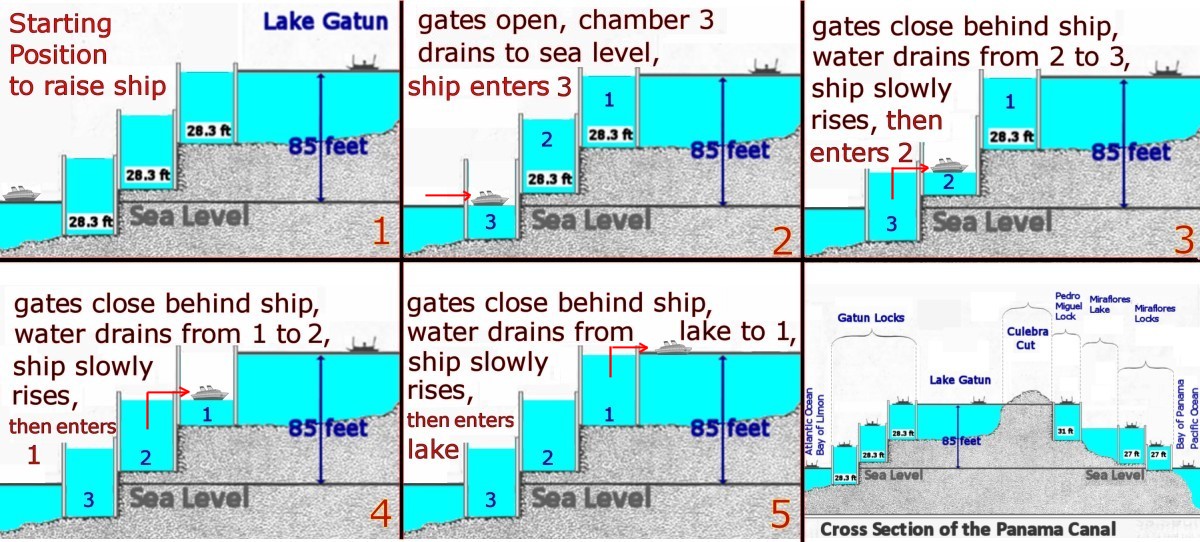 |
|
|
Water Concerns
The weakness in the system is water. There are six
locks total and each one is huge. Each canal lock measures
110 feet across and 1,050 feet in length, with solid steel
gates six feet thick.
Each passage through
the canal requires 52 million gallons of freshwater to float
the ship through locks. This means
nothing to someone not used to thinking in those terms, so
let's do it this way. An Olympic-sized swimming pool
holds 253,125 gallons of water. That means every trip
of a ship through the Canal requires filling 200 massive
swimming pools.
|
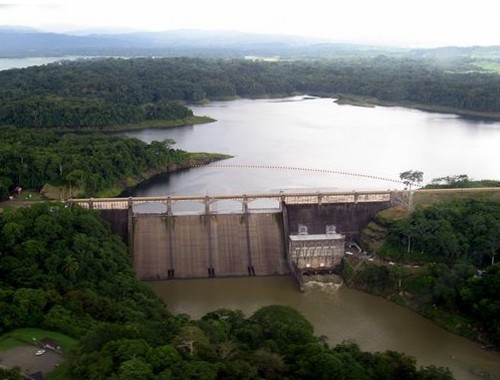 |
Whether a ship
rises or lowers at the Gatun Locks, either way the
water used in the process is eventually going out to sea.
The question is: does it rain enough to replace the water?
Back in the days before it was dammed, the Rio Chagres used to flow out to sea
all day long. So it is hard to imagine
much of a difference. However, now water has to go out
to the Pacific locks as well. In other words, the demand on
the water faucet known as the Chagres River has doubled.
Seeing the need to conserve water, in 1935 the U.S. built
Madden Dam up in the mountains to create Alahuela
Lake. This reservoir traps the Chagres waters
closer to its source. This lake has become an essential
element in making sure the canal has an adequate water
supply.
The lake has a maximum level of 250 ft above sea
level and can store one third of the canal's annual need.
For the time being, there's enough water.
However, changing climate patterns deforestation, and increased shipping demand at the
Canal has everyone in Panama
worried about the future.
|
|
|
|
How Long is the Panama Canal?
The exact length of the
Panama Canal varies
depending at which point you wish to use to start counting the
mileage. Many people just say 50 miles and leave it at that.
The time to cross the Canal is about 8-10 hours.
By comparison, the
Houston Ship Channel is roughly the same length. The big
difference is the Houston Ship Channel merely had to dredge the
bottom of Buffalo Bayou to create a sea level route deep enough for
big ships to enter. Rumor has it that the Panama Canal is a
bit more complicated.
On the right you see the
Miraflores Locks, Miraflores Lake, the Pedro Miguel Locks, and part
of the
Culebra Cut channel including the Centennial Bridge. Those towers
in the background are at the Continental Divide.
This picture shows the
water at three distinct levels. The Panama Canal is an
engineering marvel that just boggles the imagination.
|
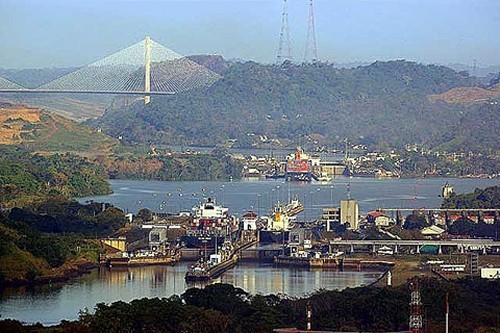 |
Distance Chart
The following description assumes you are entering from the Atlantic
side of the Canal. Reverse it if you are entering from the
Pacific.
- Limón Bay
(Bahía Limón), a huge natural harbor on the Atlantic side,
provides anchorage for ships awaiting passage. It runs
5.4 miles from the outer breakwater to the Gatún Locks. An
extra 2 mile channel forms the approach to the locks from the
Atlantic side.
Total: 7.4 miles
- The Gatún Locks,
a 3-stage flight of locks 1.2 miles long, serve to raise
ships from sea level up to the level of Lake Gatún or lower
ships coming from the Pacific direction.
Total: 8.6
miles
- Lake Gatún,
an artificial lake formed by the building of the nearby Gatun
Dam, carries vessels 15 miles
across the isthmus using pretty much the same channel originally
created by the Rio Chagres.
Total: 23.6 miles
- The Chagres
River (Río Chagres), a natural waterway enhanced by the
damming of Lake Gatún, runs east-west
5.3 miles between the
Culebra Cut and Lake Gatun.
Total: 28.9 miles
- The Culebra Cut
(aka Gaillard Cut) slices 7.8 miles through the Continental
Divide at an altitude of 85 feet and passes under the
Centennial Bridge just before reaching the Pedro Miguel
Lock.
Total: 36.7 miles
- The single-stage
Pedro Miguel Lock is 0.9 miles long. It is the first
part of the descent (or ascent) to the level of the Pacific
Ocean. This lock has a drop of 31 feet. It takes a
ship from
85 feet level down to the level of Miraflores Lake.
Total: 45.6 miles
- The artificial
Miraflores Lake is the next stage. Resting at an elevation
of 54 feet above sea level, it is
1.1 miles long.
Total:
46.7 miles
- The two-stage
Miraflores Lock system, including the approach wall, is
1.1
miles long. Each stage
raises or lowers a ship 27 feet. So the combination adds up to a total lift or drop of 54 feet at
mid-tide.
Total: 47.8 miles
- From the Miraflores
locks, ships travel at sea level
8.2 miles down a channel to the
Gulf of Panama on the Pacific side, passing under the Bridge
of the Americas in the process.
Total: 56 miles
|
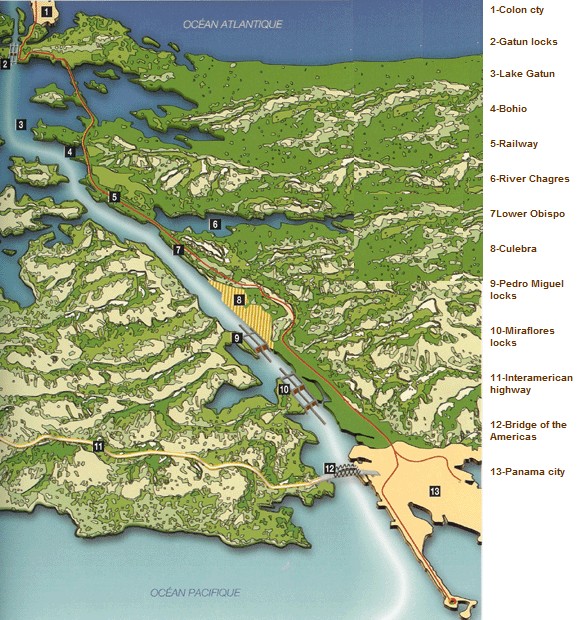 |
The Panama Canal
is called a "Lake and Lock" system. It is essentially a river
(Chagres) and a lake (Gatun) flanked by locks on either end. Here is a
detailed
look at the various sections.
Colón (1) is a
sea port on the Caribbean Sea coast of Panama. Colón overlooks
the enormous Bay of Limon which serves as the Atlantic
entrance to the Panama Canal.
At the back
of the Bay of Limon lies the Gatun Locks (2) which link
the Bay of Limon to
Lake Gatun (3)
Once the ships reach
Lake Gatun, they float for 15 miles down a channel that was
once the
Rio Chagres before the lake was created. Bohio (4) is considered the end of
Lake
Gatun and the start of Rio Chagres.
The upper part of the
Chagres River (6) merges with the Canal at a town known as Gamboa (6).
The Obispo (7)
was once a short river that served as a tributary of the Rio
Chagres. The Obispo River was dredged out and used to connect
Gamboa to the Culebra Cut (8), aka the "Big Ditch".
The ship reaches the end of its journey 85 feet above
sea level at a place known as the Pedro Miguel Locks (9).
These locks connect the Culebra Cut to Miraflores Lake.
The Pedro Miguel
Locks lower the ship 31 feet
down to
Lake Miraflores. One mile later they reach the Miraflores Locks (10).
At this point, the ships
are now lowered again
through the Miraflores Locks to sea
level. The ship passes under the
Bridge of the Americas (12) at Panama City
(13).
|
|
History of Events Leading to the Creation of the Panama Canal |
No tale of the Panama Canal can possibly be complete without a study
of the factors which led to the building of the Panama Canal.
There had been a strong desire to have a
canal run through the Central American isthmus since the early 16th
century when the Spanish dominated the region. The
Spanish long sought to build a canal to achieve an easier route to
access their colonies on the Pacific side.
The
Spanish government had plans in place, but
no action was ever taken.
Interest intensified to build a canal when
gold was discovered in California in 1848. American settlers,
looking for land and gold, wanted a quicker route than the
arduous and often dangerous trek across continental U.S.
The American government
was also interested, but for a military reason. The Canal
would be important for security reasons. The military did not
like having its navy divided from one ocean to the other.
|
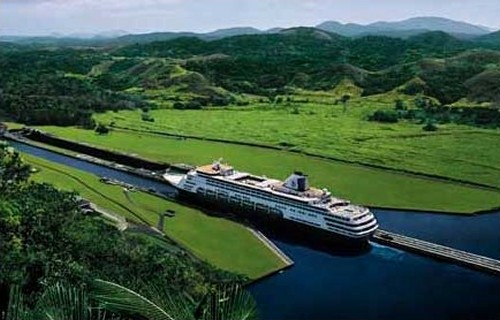 |
|
|
Monroe Doctrine
The Monroe Doctrine
is a U.S. policy that warned any further efforts by European
countries to colonize land or interfere with states in the Americas
would be viewed as acts of aggression.
The doctrine was
introduced by President James Monroe on December 2, 1823, when he was enraged at the
actions of various European countries taking place in the Caribbean
and Latin America.
The Monroe Doctrine
asserted that the Americas were not to be further colonized by
European countries. In turn, the United States promised it would neither
interfere with existing European colonies nor meddle in the internal
concerns of European countries.
The Doctrine was issued
at a time when many Latin American countries were on the verge of
becoming independent from the Spanish Empire. The United States,
reflecting concerns raised by Great Britain, ultimately hoped to
avoid having any European power take over Spain's colonies.
The British worked hand in hand with the United States in upholding
the doctrine. This was the start of the special
relationship between England and the USA that remains today.
|
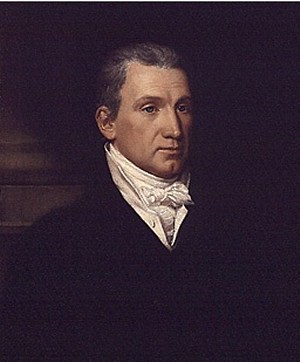 |
The Monroe Doctrine became a defining moment in the foreign policy
of the United States. It basically told everyone that the USA
was now in control of the waters on this side of the Atlantic
whether Europe liked it or not.
The Monroe Doctrine remains one of our country's longest-standing tenets.
It has been invoked by several U.S. presidents, including Theodore
Roosevelt, Calvin Coolidge, Herbert Hoover, and John F. Kennedy (Cuban
Missile Crisis). One recent use of the doctrine was in 1983.
Ronald Reagan used it to justify sending marines to a small
Caribbean island nation known as Grenada to put down a communist
overthrow of the government.
Monroe surely had no way to envision that his
Doctrine would persist with only minor variations for the next two
centuries. Its primary objective was to free the newly independent
colonies of Latin America from European intervention and control
(thus ensuring US national security). However, the doctrine has continued to have
impact for 200 years because it makes a lot of sense.
Truth be told, America
did not have the muscle to completely enforce the doctrine at the
time. However, in
Great Britain the U.S. had a "Big Brother" that did have the necessary
muscle. Known as "The Special Friendship", the political
destinies of England and America became nearly parallel throughout
the 19th Century. Every European power knew full well that to
mess with America meant to take on the British as well. Nobody
dared.
1898 was a turning
point. The
1898 Spanish-American
War fought down in Cuba resulted in a devastating defeat on the part
of Spain. This war not only marked the end of any Spanish presence in the
Caribbean Sea, it showed the world that America had become a
superpower in its own right. America began to emerge from the
shadow of its big brother and stand on its own two feet.
The man who deserves the
most credit for America's emergence at the forefront of the World's
stage was President Theodore Roosevelt. Roosevelt's time in
office was remarkable in many ways. He would come to be regarded as
one of our country's greatest presidents.
Thanks to Teddy
Roosevelt's ensuing buildup of the Navy in 1901, the U.S. began to
treat the Caribbean Sea as its very own personal recreation pond.
Now that America had become a superpower, the Europeans got the
message: Not in my back yard.
Theodore
Roosevelt
Theodore Roosevelt, who became president of the United States
in 1901. For someone nicknamed "The Teddy Bear", President Teddy Roosevelt
was undeniably aggressive. His famous motto was to "speak
softly, but carry a big stick".
Roosevelt got his start
fighting police corruption in New York City during 1880s. He
parlayed his good work there to a position in the Cabinet as
Secretary of the Navy. His stay was short-lived. When the 1898
Spanish-American War broke out, Roosevelt resigned his post to
form the Rough Riders. He headed down to Cuba to join the
fighting. He would win fame for his bravery down there.
Next Roosevelt won
a close election as governor of New York, but he didn't stay long in
that position. Instead he soon accepted the position of
Vice-President in the 1900 McKinley administration. He didn't
stay long in that position either. When McKinley was
assassinated in 1901, Roosevelt stepped in as President.
Thanks to all that fast-tracking, at 42 years, Roosevelt was our
youngest president to date. Roosevelt was the right man at the
right time. He
was a vigorous man eager to assert American
influence across the planet.
|
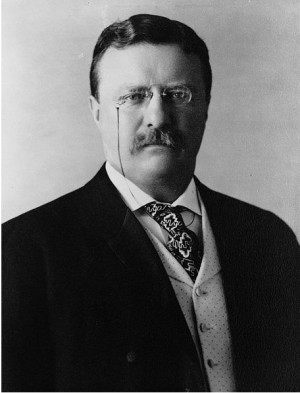 |
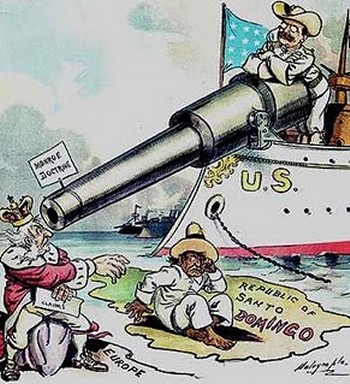 |
The Monroe Doctrine had
told Europe to mind its own business, but The Roosevelt Corollary
went one step further.
Thanks to its success at effectively
kicking Spain out of the Americas in the 1898 conflict, the United
States had begun to truly flex its muscles for the first time.
Now the country had just the right guy to flex those muscles a lot
more.
Roosevelt quickly made it clear that
America would intervene in any messy political situation involving
Latin America if it was in U.S. interests to do so.
Political events
involving Cuba, Panama and Venezuela led Roosevelt to assert the
right of the United States to intervene in Latin America affairs in cases of
“flagrant and chronic wrongdoing by a Latin American Nation”.
The U.S. made it clear it would be looking over the shoulder of all
its neighbors from now on. The Roosevelt Corollary to the Monroe Doctrine was invoked to
justify military intervention in Latin America to stop the spread
of European influence.
|
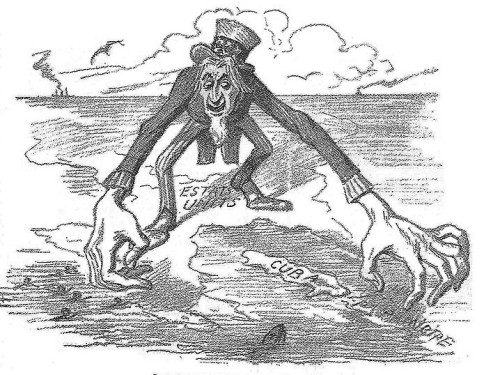 |
The Roosevelt
Corollary was widely opposed by his critics. They
argued that the Monroe Doctrine was originally meant to stop
European influence in the Americas, not to interfere with
the actions of neighboring nations.
Roosevelt could have cared less. His Corollary asserted the
obvious fact that since the U.S. had domination in the Americas, it
would not passively sit around during conflicts. Henceforth, the
United States would play the role of "hemispheric policeman".
If anyone doubted
Roosevelt was serious about his willingness to use the military to
intervene in Latin American politics, the coming situation involving
Panama quickly dispelled those thoughts.
|
|
|
|
|
Alfred
Thayer Mahan
Alfred Thayer Mahan was
a Naval officer who won fame as a Naval historian and as the leading
Naval strategist of his day. Mahan was called "the most
important American strategist of the nineteenth century."
His concept of "sea
power" was based on the idea that countries with greater naval power
will have greater worldwide impact. His ideas still permeate the
U.S. Navy Doctrine.
Mahan was appointed
President of the Naval War College in 1886. One year later
Mahan first met Theodore Roosevelt, who came to the college as a visiting lecturer.
The two men became fast friends. Three years later, Mahan
published his famous naval doctrine, "The Influence of Sea Power
upon History, 1660-1783". Theodore Roosevelt read the newly
published book in a single weekend.
Roosevelt never forgot
what he learned from the book. Roosevelt completely agreed the
United States would need to protect its sea lanes around
the world to become a great nation.
Thanks to the ideas of
Mahan, Roosevelt
became obsessed with naval power. Sea
power was necessary to facilitate trade and peaceful commerce,
so the country with the greatest sea power would be able to
wield great influence on the world stage. Therefore, long
coastlines, good harbors, and power over places
like the Suez and the soon-to-be
Panama Canal was essential.
|
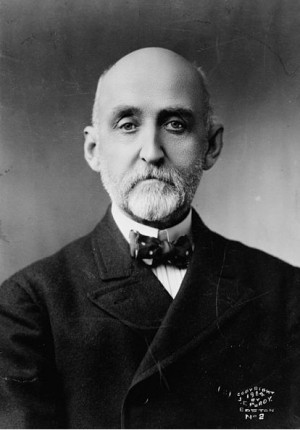 |
| |
|
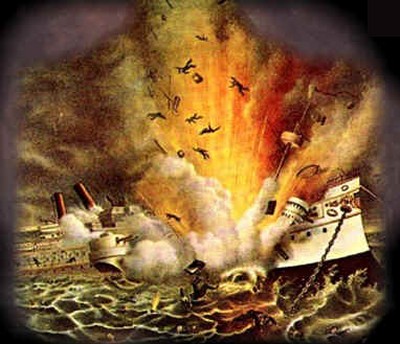 |
Roosevelt and
the Spanish American War
By the turn of
the century, the Spanish had long outstayed their welcome in
the Caribbean. The people of Cuba were desperate for
independence.
All the U.S.
needed to intervene was an excuse. Following the
mysterious sinking of the USS Maine in the Havana harbor,
the U.S. had exactly the excuse it needed. In fact,
the sinking of the Maine was so mysterious that legend
suggests the USA blew the ship up itself. But that is
another story.
To the cries of
"Remember the Maine!", Spain and the U.S. began a major
conflict in 1898 which took place down in Cuba.
The USS Oregon,
a battleship stationed in San Francisco, was dispatched to
take the Maine's place, but the voyage around Cape Horn took
67 days.
Although the USS
Oregon finally arrived just in time to join in the Battle of
Santiago Bay, the voyage would have taken just three weeks
via Panama.
|
This delay had been very
upsetting to the US Navy. What would happen if the U.S. was
involved in another major war that required the rapid use of naval
power trapped in the wrong ocean? The frustration gave rise to
the idea that a U.S.-controlled canal across Central America was of
vital strategic interest to the U.S.
Interestingly, this
theory was quite prescient.
The anticipated military significance of the canal was
finally proven in
World War II. After Pearl Harbor,
the Panama Canal proved crucial when the United States used the canal to help revitalize
their devastated Pacific Fleet. The immense
strategic value of the Panama Canal allowed the U.S. to "reload" in
the Pacific a lot faster than the Japanese had expected.
Back in 1898, Teddy
Roosevelt had played a major role in the
Spanish-American War.
There he gained fame for his charge up San Juan Hill along with his
Rough Riders.
Unwilling to sit back
and command from the rear, Roosevelt was right in thick of the
fight. He actually led the charge himself despite facing heavy
gunfire that cost many lives that day. Roosevelt was later
given the Medal of Honor for his courage and leadership.
Although he was an Army
guy during the
fighting in Cuba, Roosevelt had found time to pay close attention to
the frustrations of the Navy
following the
destruction of the battleship USS Maine.
|
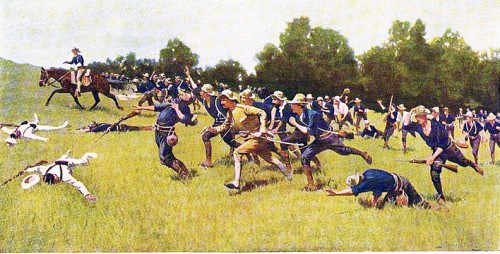 |
Interest in
Panama Grows
A
firm believer in Captain Mahan's theory of sea power,
the moment Roosevelt became President in
1901, he immediately took
steps to revitalize the U.S. Navy.
During
the Spanish-American War of 1898, the United States had gained
control not only of Cuba, but the Philippines and the island of Guam.
By coincidence, the annexation of Hawaii had just taken place in
1898 as well. Mahan's ideas of national security had strongly
recommended bringing Hawaii
into the fold. Now that America's empire stretched from the Caribbean across
the Pacific, the old idea of a canal connecting
the two oceans took on new urgency. Recalling
the lessons learned down in Cuba, Panama was foremost in Roosevelt's
thoughts.
Mahan had predicted that "the
Canal will
become a strategic center of the most vital importance."
Teddy agreed. "The canal," Roosevelt said,
"was by far the most important action I took in foreign affairs
during the time I was President. When nobody could or would exercise
efficient authority, I exercised it myself.
That canal had to be built hell or high water."
"No single great material work which
remains to be undertaken on this continent, "Roosevelt said, "is as
of such consequence to the American people."
However, before any work
could begin on the Panama Canal, Roosevelt would first have to pick
up the pieces from the French.
|
Ferdinand de
LessepsFerdinand Marie de Lesseps was
an entrepreneur extraordinaire. A citizen of France,
de Lesseps was the man responsible for the construction of the
Suez Canal which was completed in 1869.
De
Lesseps was not an engineer or an architect,
but he was a dreamer and schemer of the first magnitude.
According to his admirers, de Lesseps had nerve, imagination,
dynamic energy, persistence,
plus a talent for propaganda
and maybe even a capacity for deception.
With his outgoing social manner and his
dream firmly in place, the moment de Lesseps
completed the Suez
Canal project, he began looking for his next great
accomplishment.
De Lesseps had fascinating
ideas that kept the public
enthralled. He envisioned railways from Paris to Moscow to Peking.
He talked about creating an
inland sea in the Sahara Desert by breaking through a ridge on Tunisia's
Gulf of Gabes and flooding a depression the size of Spain.
De Lesseps was one of
the few men on earth actually capable of getting these gigantic undertakings
off the ground.
He was able to
obtain and handle money like no other man in his
time. Due to his immense charm and his Suez
success, people in high places were willing to hear him out on his
Panama concept. He was now one of the most famous men in the
world.
|
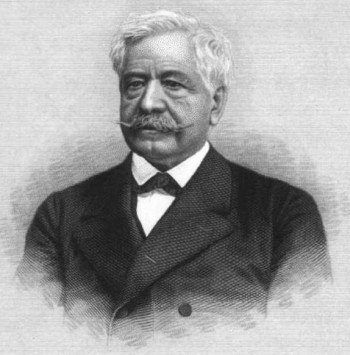 |
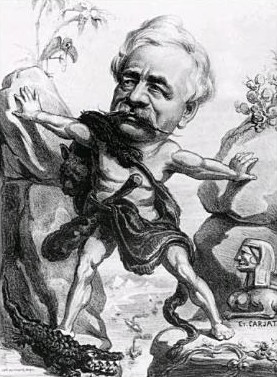 |
With completion
of the Suez Canal, de Lesseps changed the
world and captured its imagination.
By coincidence, the completion of the
Suez Canal concurred with another famous event - the completion of
the first US transcontinental railroad. These two events made
the entire world a much smaller place. Another famous dreamer
in his own right - Jules Verne - took note and wrote his famous
"Around the World in 80 Days". This saga described a journey that used both the Suez
Canal and the U.S.
railroad developments in the plot. It was a great book that
captured the spirit of these exciting
times.
In
1875 de Lesseps decided to take on the
project of building a canal between the Pacific and
the Atlantic
in Central America. He was definitely the
right man for this massive project.
De Lesseps was
viewed around the world as an all-conquering hero.
His work on the Suez Canal
gave him the international acclaim necessary to garner financial
support for this new undertaking. Everyone agreed if anyone
could do it, that would be Ferdinand de Lesseps.
In May of 1879, de Lesseps hosted a meeting
with delegations of 22 countries around the world.
In this meeting, there was much discussion
over the
tactics on how to build the canal. This delegation
brought suggestions to the floor on the type and location.
The first issue
was a
debate over whether the canal should be built in Panama or
Nicaragua.
|
When Panama was chosen, the next argument
was whether it should be a sea level canal or a
lake and lock canal. De
Lesseps declared that it would have to be a sea level canal.
A lot of people quietly
believed de Lesseps was making a big mistake. The problem of a sea level canal was seen
right away in terms of the landscape that the canal was to be built
on.
The Chagres River was
seen as the single biggest obstacle to the success of the project.
Any canal at
Panama - a lock canal or
a sea-level canal -
would have to cross the river at least once.
Surely the canal would
have to pass the bend of the Chagres River at Gamboa. The
river was 42 feet above sea level at this point. If a
sea-level canal were cut through, the river would
fall to the canal
from 42 feet above.
It would definitely make for a spectacular waterfall, that's
for sure.
In the rainy season the river could be instantly transformed
into a torrent, rising ten feet in an hour. The
cost of controlling so monstrous a force -
if it could be done at all -
was beyond reckoning.
|
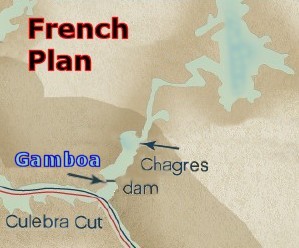 |
De Lesseps was
undeterred. One of his greatest skills during the building of
the Suez Canal had been his ability to ignore the critics and
naysayers. The French had the greatest engineers in the world.
De Lesseps was certain that when the time came, his engineers would figure out a way to bring this
tropical river into line with his project. Bristling with
supreme confidence, De Lesseps
immediately started fundraising and propagandizing the campaign.
Investment money came pouring in. The
project was a go.
Construction began in
Panama
in
1880. Almost from the start, everyone could see this was infinitely more challenging than the Suez in every aspect except
for the distance. Furthermore, any
lesson that the Suez had
provided was useless. The
French had assumed building one great canal would make the second
one easier, but they were wrong.
This wasn't sand they were digging through, it was
rock!
Just to get started, the
French had to go into a thickly matted jungle that had poisonous
reptiles, jaguars and pumas, as well as tons of insects.
In the summer of 1881,
the French discovered to their dismay they had an enormous
unanticipated problem to deal with - yellow fever and malaria.
As the number of laborers increased,
so did the death rate. By the end of 1883, 1,300 laborers had died
throughout the year. Fear and anger surged
through the ranks. This damn Canal was a death trap!!
|
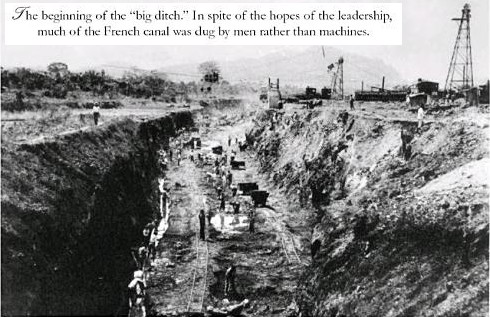 |
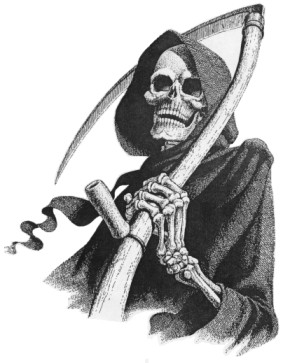 |
The rate of sickness seemed to only get worse.
At the peak of the problem laborers were
dying 200 per month. The worst year for the French
regime in Panama was 1885, where up to forty people per day died at
times.
All told, the French lost an
astounding 22,000 men in the process. There have been many
well-known wars where the casualty rate came nowhere close to that kind of
mayhem. Getting sick was tantamount to a death sentence. Half
the people who got sick died.
Be it lowly diggers or
the important college-educated engineers, no one was
safe. Vast
numbers of employees ranging from laborers to top directors of the
French company were sickened and killed. The specter of death
hung over the project. What was killing these people?
At the time, no one had any idea what was causing the
problem or how to combat it. The amount of fear and
dread was unbelievable. Everyone felt defenseless.
Would today be the day?
The French got away with
this death rate because they kept it a secret. They recruited
most of their labor force from French-speaking islands in the
Eastern Caribbean. They made sure news of this problem did not
reach those islands. They make it very difficult for people to
leave.
No matter how hard French officials tried to suppress the news, something
this serious could not stay hidden forever. Once the general
public discovered the truth, no one else would risk their life and
sign up to work. The French had no choice but to quit.
|
The death toll was not the only number
increasing at a rapid rate. So too was the financial cost.
De Lesseps’ efforts to raise the
proper money were without comparison in his time. He was truly
talented at raising money for his projects and inspired many of his
countrymen. Unfortunately, the conditions kept getting more arduous
in Panama and de Lesseps had to keep justifying to the French
government to give him more money. While his efforts were valiant,
in February
1889, the shareholders of the original company assigned a liquidator
and the French effort was brought to an end.
De Lesseps could only whisper, “It is
impossible! It is shameful!”
In the end, de Lesseps'
constant optimism proved his ultimate undoing. As he had done
at the Suez Canal, he refused to listen to people who disagreed with
him. For example, the construction of the Old Panama Railroad 20
years earlier had cost upwards of 6,000 lives due to disease.
De Lesseps knew about this tragedy, but paid no attention to it. That sobering fact
should have dampened de Lesseps' enthusiasm, but he just ignored it.
Just because all those men died in 1860, why should they die in
1880?
As yet another example of his insouciance, de Lesseps only Panama once
before starting the project. His visit had taken place
during the relatively mild dry season. While he was there, he saw nothing that
bothered him very much. People who knew Panama intimately
tried to warn him, but de Lesseps dismissed them. He simply
wasn't the kind of person who wanted to hear negativity.
Unfortunately, his
over-confidence led him into a trap. Once construction
began, his crew
discovered the real Panama - mile upon mile of impassable jungle,
day upon day of torrential rain, insects, snakes, swamps, hellish
heat, smallpox, malaria, and yellow fever.
Perhaps his greatest
mistake was ignoring the Chagres River. The Chagres snaked
across the proposed canal route a total of fourteen times. Ignoring
the warnings of engineers who deemed the task impossible, de Lesseps
had decided he would dam and divert the river, which he had only seen
first-hand at
low ebb during the dry season. Now suddenly in the rainy season, the engineers paled
as the Chagres rose to a monstrous, churning torrent that swept away
anything that stood in its way. This angry, swollen river was distinctly inhospitable to
taming.
For ten long years, nothing went right.
De Lesseps
would die 5 years after the project collapsed. The
countless deaths, the unending harassment of his creditors, the
jeering criticism of his enemies and the knowledge that he had
failed in the greatest effort of his life made his final days sheer
torture. Some people suggested he died because he wanted to.
So much for the man who
pursued his dreams. He was a tragic figure, a broken man. Like the story of Icarus, the birdman who
flew too close to sun, de Lesseps' fate is a grim reminder that
while some visionaries succeed, many others die when they shoot for
the moon.
In the end, de Lesseps was caricatured as the man
who started as a canal digger, but became a grave digger instead.
How is that for an epitaph?
|
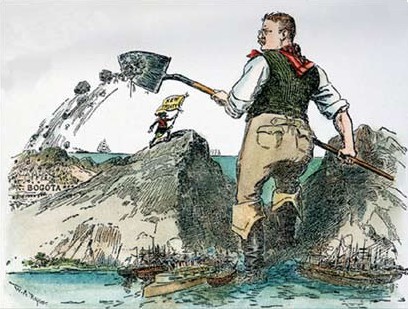 |
Gunboat Diplomacy
Thanks to the French
collapse, the United States saw
a golden opportunity. However, the
Americans were not naive. They could see there were enormous hurdles to be
crossed.
After studying all angles of the
issue, Roosevelt was persuaded by Mahan's theory of naval power that
the advantages were worth the risks.
The moment Roosevelt took office
in 1901, he ordered his staff to begin negotiations with the French
for the rights to the Panama Canal project.
The
French were more than happy to comply. It would be nice to
recoup some of their immense financial losses. Roosevelt agreed
to pay $40 million for the rights... and was
immediately criticized by the press who suggested he could have
gotten a better deal.
The United States
government voted to begin work on the Panama Canal in 1903.
However, since Panama was a territory of Colombia, first the U.S.
needed to obtain the same permission from the Colombians that had
previously been given to the French.
|
The government of
Colombia noticed how much money the French had received and decided
to play hard to get. Colombia decided to vote against the project.
Roosevelt was incensed. This was
basically blackmail.
Roosevelt had offered $10 million
- quite a sum of money in that day - for a fifty-mile strip of unused,
uninhabited jungle across the isthmus only to
see Colombia refuse.
The Colombian government wanted
significantly more money.
Roosevelt had no intention of paying
any ransom money. He realized he had a better option, but it would
force
him to engage in a bit of political skullduggery to
get the project going again.
"We were dealing with a government of irresponsible
bandits," Roosevelt stormed. "I was prepared to
occupy the Isthmus anyhow and proceed to dig the
canal whether Colombia liked it or not.
But I deemed it likely that there would be a
revolution in Panama soon."
Teddy already knew there
was a powerful independence movement taking place inside Panama.
The people who actually lived in Panama knew the canal was clearly
in their best interests. They deeply resented the interference
of Colombia. And why should Colombia get all that money?
The people in Panama would never see a cent of it.
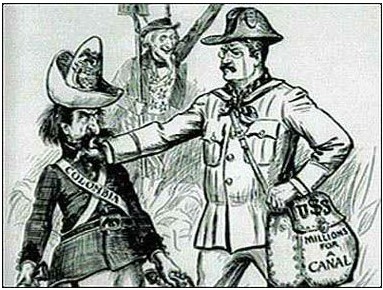 |
Just as important, the
chief engineer of the French company
holding the rights desperately wanted the sale to go through. Roosevelt smiled. Why not help the local
people a little? So the United States sent word they
would support a
revolt in Panama. Encouraged, the French engineer
organized a
local revolt.
Roosevelt immediately sent the battleship
Nashville and a detachment of marines to Panama to support
the new government. The US Navy just happened to show up
in a bay outside of Colombia a
day before the revolt.
The revolt started and
ended in two days. Colombian troops
were immediately dispatched to quell the opposition, but found their sea lanes
blocked by American warships. The dense jungle
separating Colombia and Panama made a land approach
impossible, so there was no chance of reinforcement by land.
|
And what about the
Colombian soldiers stationed in Panama? Colombian soldiers in
Colón were bribed $50 each to lay down their arms. Faced with
the choice of dying or getting significant money to ignore a fight
over a place they could care less about, their desire to
resist quickly faded. The Revolution took place without any loss of
life. Just like that, the new Republic of Panama was
born.
Not surprisingly, the
new government was much more cooperative.
The rebels gladly accepted Roosevelt's
$10 million offer and gave the United States complete
control of a ten-mile wide canal zone. A lease was quickly signed
and construction followed shortly
after. Using the abandoned French machinery,
the United States
began working on a lock-based canal
a year later in 1904.
|
Political Opposition at Home
Given the
crushing failure of the French, the success of the American effort
was in no way guaranteed. There was an alarming amount
of disagreement on whether this project made any sense.
Roosevelt faced a
lot of heat back at home.
Looking back in
time from our 100-year perspective, it isn't easy for us to
understand that there was tremendous political opposition to the
building of "The Big Ditch" as it was called. However,
we have the advantage of history.
From the point
of view of Roosevelt's critics, he was taking an enormous
risk. Thanks to the French problems, failure seemed a
real possibility.
Back when the
feasibility of the Canal project was being debated, the
enormous cost and the awareness of all the problems the
French had faced caused many important people to dismiss the
project as a preposterous waste of money and time.
|
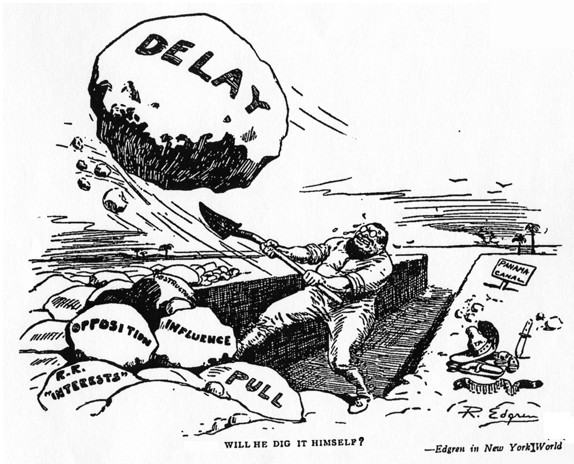 |
The critics were mad
about all sorts of things. First they were mad that the U.S.
had given the French too much money for rusting equipment.
Next, the political
opposition of the Colombian government played right into their
hands. Roosevelt's political enemies deeply criticized
Roosevelt's use of bullying tactics to solve the problem.
The major risk of life
due to the mysterious disease was yet another added negative.
As news of the enormity of the French loss of life slowly became
more widely known, there was a lot of fear involved.
To Roosevelt's opponents
in
1904, they assumed Roosevelt was biting off more than he
could chew. If a great man like de Lesseps with a
proven track record couldn't do it, what made Roosevelt
think he could? Everyone knew Roosevelt was brave, but
charging up San Juan Hill with the Rough Riders wouldn't
help in this case unless those Riders had shovels.
Too bad
Roosevelt was merely a President. Unlike the Pharaoh
who could simply order men to build the Pyramids or face death, Roosevelt had to answer to
all these people.
Fortunately, President Roosevelt refused to cave in.
He gamely took on all comers and argued them down.
Roosevelt later
reminisced, "There was much accusation about my having acted in an
'unconstitutional' manner. I took the
isthmus, started the canal, and then let the
Congress debate me. They can
debate all they want. While the debate
goes on, the canal does too. They are welcome to debate
me as long as they wish, provided that we can go on with the
canal."
His
political critics weren't his only problem. Although Roosevelt
maintained a strong public face on the Canal project, secretly he
was starting to have his doubts as well. Thoughts of the French
failure weighed heavily on Roosevelt.
Roosevelt realized how fragile his margin of support was.
The project had gotten off to a terrible start.
Roosevelt
knew that the Americans' first year in Panama
had closely mirrored the French disaster.
Same problems, same lack of solutions. Now people were
starting to die down there. The clock was ticking.
Roosevelt grimly wondered if he was facing failure on a giant
magnitude.
The first chief
engineer on the job, John Wallace,
was ineffective. He neglected to organize the effort or to develop an action plan. The
food was putrid, the living conditions abysmal. Nor
did Roosevelt's opponents make it easy for Wallace to succeed. Political
red tape created by Roosevelt's enemies put a stranglehold on appropriations.
The mountains of red tape
drove Wallace out of his mind with frustration.
Then the disease
began.
Uh oh. The Americans weren't trapped like the poor
miserable Caribbean who had been stuck there. 3 out of 4 Americans booked passage home
at the first chance. During 1904 the
Americans had poured $128,000,000 into the swamps of Panama
and had practically nothing to show for it. Roosevelt was
discouraged. Things didn't
look too good down there.
As problems mounted in
Panama, Roosevelt knew he was
taking a serious gamble. Only the extreme
distance kept this negative news from breaking in the papers.
Roosevelt worried that he was running out of time. One serious disaster
and
the voices of dissent would become nearly unbearable. Considering
all the opposition he faced, politics was obviously not for the
faint of heart.
Roosevelt
didn't trust his engineer Wallace.
He recalled the man to the White House and demanded his resignation. Wallace was thrilled to give it to
him. Wallace had some parting words. "No one can save this project."
Chilling words indeed.
|
John
Frank
Stevens
Well aware of the problems
Wallace had run into, a sense of déjà vu haunted Roosevelt. He knew
the French engineers were in all probability just as good as the
American engineers. How could the Americans succeed where
competent men from another country had failed so miserably?
And what about this infernal sea level versus lock system debate?
Roosevelt was down to his last chance.
The man who saved the day was John Frank Stevens, Chief Engineer from
1905 to 1907. Stevens was the man who convinced
Roosevelt the
idea to build the "locks" was the right move.
The decision of
which canal system to use was highly controversial. No one
could be sure which system would work because something on
this scale had never been attempted before.
There was no consensus; the experts were split
right down the middle. Some said the sea level approach was
best and others said the locks system was best.
The first American to
ever investigate the idea in depth was
Commander Thomas Selfridge.
In 1870 he took two expeditions through
Panama's Darien Gap.
Selfridge was certain on how the
canal should be built, saying it must be "through-cut" at sea level.
Ferdinand de Lesseps was convinced sea level was the way to go.
John Wallace, the first American Chief Engineer on the project, had
also been convinced that sea level was the way to go.
Furthermore, the U.S. commission assigned to study the question
pointed out the sea level approach had worked in the Suez. They
all agreed with Wallace. Build the canal at sea level!!
|
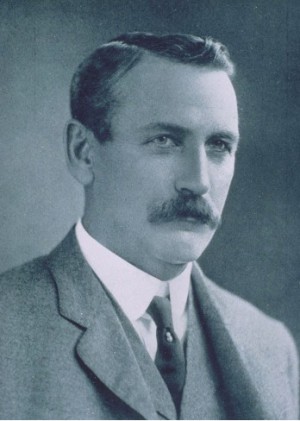 |
|
Betting
the Farm on a Radical Idea
It takes a lot
of guts to contradict intelligent, educated men who are
convinced they know what's right. Was John Frank
Stevens qualified to make a decision of this magnitude?
What was his background? What papers had he written?
What exactly was his training?
Stevens had no
canal training at all. Zero. Nada. He wasn't an
architect. He wasn't an engineer. Heck, he
wasn't even a college graduate. Even more ridiculous, he had
never been near water in his life, much less dug a canal.
On paper, John
Frank Stevens could not have been less qualified.
Stevens was a
railroad man... a very good one at that. That skill
would come in handy when moving the dirt around, which is
what got him the interview with Roosevelt in the first
place.
But what did
building railroads have in common with building canals?
Probably not much, but it didn't matter. Stevens was a
practical man, self-taught. He had twenty years of
experience at building railroads and managing large
projects. Stevens figured whatever he didn't know, he
could learn.
Stevens
understood the main decision facing the engineers was
whether to build a sea level or high-level, lake-and-lock
canal. The stakes were enormous. No one could
afford to get it wrong. There was no room for error.
The French had chosen Panama
over Nicaragua primarily because they believed it could
support a sea-level canal, the system they were more
comfortable with.
As the picture
from "How
Stuff Works" shows, the French were ready to carve
through whatever was in their way for 50 miles.
|
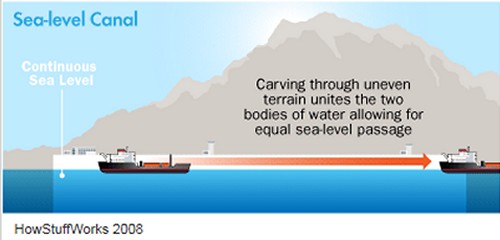 |
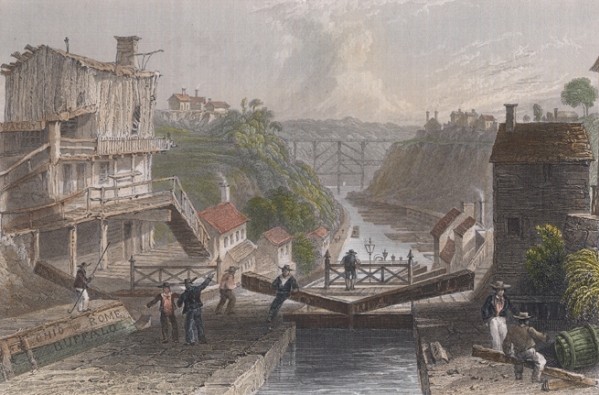 |
The French were
unwilling to take a high-stakes gamble on locks. No one
could be sure the "lock technology" of the day was advanced
enough to work with huge ships. This wasn't exactly
the Erie Canal they were proposing to build.
Yes, the "lake
and lock" approach was perfect for the small ships that
operated on rivers and lakes. But these were giant, heavy ocean
liners they were dealing with, not some wooden tub on a
lazy river. Would locks work with the enormous freighter
ships of the ocean? There was no solid evidence they would.
Using locks with modern ships was unproven technology.
In some ways,
the French were victims of their own success. The
French did not like taking chances. Thanks
to their world-renowned accomplishment at the Suez Canal, the French
could not seem to let go of the sea level approach.
The sea level canal might involve a lot of work, but it
seemed like a sure thing.
Just dig
dig dig till the whole thing was done. Let the Pacific
waters kiss the Atlantic waters in perfect harmony in the
middle of the canal at sea level. Voilà!
The French Connection!
|
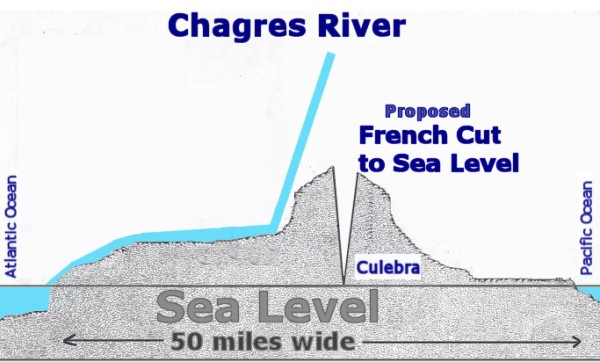 |
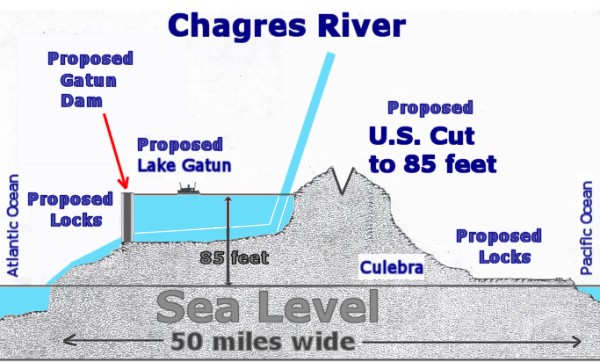 |
Rick's Note: I drew these two pictures
based on my understanding of what I read. What I am about to
say is a bit harsh, so I wish it to be known that these are
my words alone. I wasn't there, so let's be clear I am
drawing conclusions based solely on what I have read and
nothing else. As they say, take my words with a grain
of salt.
CULEBRA CUT
The French plan was
to build at sea level. The eventual U.S. plan was far
more complicated. The top of the Continental Divide at
Culebra was 336 feet high. Unless I am missing
something, that meant the French planned to cut through 336
feet of solid rock down to sea level. The American
plan would call for a cut of 120 feet. Even with the
head start given the Americans at Culebra by the French, it
still took the U.S. about 8 years to finish their 120 foot
cut. How long would 336 feet have taken?
What were the French thinking?
50 MILES OF SOLID ROCK
The isthmus was 50 miles wide. Unless I am missing
something, that meant the French intended to excavate the
entire 30 mile bed of the Chagres River plus 10 miles at the
Culebra Cut (plus 5 more miles at both ends).
First of all,
how were they going to get the Chagres River to behave while
they dredged through its channel all the way to the
Atlantic? Or were they going to dig another massive
river bed right next to it?
The French had
dug through 100 miles at Suez, but a third of the distance
was lake and the rest was mostly
sand. Here at Panama, the French dug
and dug and dug for ten long years. During this time,
they partially
cleared about 11 miles of the eventual 50. At the rate
they were going, their plan
would take at least another 20 years. 50 miles of
digging through solid rock?
What were the
French thinking?
|
 |
CHAGRES RIVER Furthermore, the
French still didn't have an answer for the troublesome
Chagres River. Once
the French engineers finally saw the Chagres up close, they
did a double-take. This river was a tropical beast when it
rained. At 42 feet height above sea level, it threatened to
send massive amounts of water bearing down at a right angle
exactly at Gamboa, the spot where the "sea level"
canal would meet the Chagres.
How exactly were they supposed to
bring a 42 foot high monster down to sea level? The
ever-confident de Lesseps expected his engineers would build
a dam. Unfortunately, the spot de Lesseps had chosen
for his dam was virtually impossible since the river was so
wide at that point and there was no convenient canyon nearby
to help build the dam. The sea-level plan
seemed no match for the mighty Chagres River.
What were the
French thinking?
|
Given that it seems
so obvious to a modern reader what the correct solution was,
it is hard to accept that the French were so determined to
use their sea level concept. The only possible
explanation that makes any sense to me is that the concept
of using "locks" was far too radical for that time. To
be that stubborn, the French must have thought using locks
to build the canal made about as much as sense as telling an
ancient that the world was round, not flat.
Humans like to
pride themselves in their curiosity, but we all have blind
spots about things that make us feel foolish later down the
line when the truth is revealed. That is why education
is so important. One of the first things people learn
in education is the more we know, the more aware we become
of what we don't know. In the case of the French, this
blind spot about the correct plan to use led to one of the
most colossal engineering failures in the history of man.
|
Baron Adolphe Godin de Lépinay
In 1879
promoter extraordinaire Ferdinand de Lesseps convened a conference in Paris.
The conference had the stated purpose of inviting engineers
from around the world to make proposals on how and where to
build the canal connecting the Atlantic to the Pacific.
However, later reports suggested that the secret purpose of the
conference was simply to create an aura of legitimacy to
help raise money. By providing the appearance of
impartial international scientific approval, de Lesseps
would be able to claim that no stone had been left unturned
in approaching this project this the right way.
Unbeknownst to
many, De Lessups already had his mind made up before the
conference ever began. He favored a sea level canal plan
using the shortest distance possible in Panama. He was
drawn to his preferred location by the existence of the Panama
Railway. Not only was the jungle already clear along
this route, the train would help immeasurably in transporting
equipment, men, and earth.
Fourteen
proposals for sea level canals were presented before the
Congress. To de Lessep's surprise, the American
delegation had an excellent plan to build a canal in
Nicaragua. The well organized and persuasive presentation by
the Americans very nearly upset de Lesseps' carefully
orchestrated plans. A subcommittee reduced the route
choices to two -- Nicaragua and Panama.
De Lesseps was
forced to quietly ask various members of the large French contingent at the Paris
meeting to help vote down the Nicaragua proposal.
Then, to his
surprise, de Lesseps had another curve to deal with.
Even more surprising, the note of dissent
came from someone within his own faction. A man had the
nerve to suggest a lake and lock canal system. De Lesseps
nearly had a heart attack. It wasn't just him either.
The entire conference was aghast.
What kind of insane idea was this?
Baron Adolphe
Godin de Lépinay was a brilliant and highly experienced
engineer. He was the only person among the French
delegation who actually had any construction experience in
the tropics. In 1862, de Lépinay had overseen
construction in Mexico of a railroad between Cordoba and
Veracruz. This was one man who actually knew what he
was talking about. At the congress, de Lépinay made a
forceful presentation in favor of a lock canal.
De Lépinay
started his presentation by saying he agreed with the Panama
route over the Nicaragua route. De Lépinay then added
he had conducted a careful first-hand study of the terrain.
In his opinion, the presence of the Chagres River doomed any sea level plan
to failure. Then he dropped his bombshell - why not
raise the river? Build a dam upstream, create a lake,
and raise the river.
The audience
gasped. This was utter stupidity! Men were so
upset that they interrupted his
presentation with strong protests. De Lépinay was
completely taken aback by the sharpness of the men's voices.
Not surprisingly, their behavior
rubbed de Lépinay the wrong way. De Lépinay was known
for his intelligence, but he also possessed a condescending
attitude towards those with who did not agree with him.
De Lépinay scolded the men for their rudeness and
demanded to be heard completely. Then he made the
mistake of rebuking the protesters. "You men need to sit
down and be quiet. You have no idea what you are even
talking about."
That only served
to anger the crowd more. De Lesseps saw
an opening. He spoke up and dismissed this unusual
idea as preposterous. Upon hearing this, de Lépinay was indignant.
He reminded de Lesseps he had spent several months inspecting the location and
preparing his arguments. He resented being treated as a dilettante.
De Lesseps
knew he had the crowd on his side, so he just laughed. De Lépinay
was flabbergasted as being dismissed so easily. He
couldn't believe de Lesseps was so flippant. He
protested vigorously for de Lesseps to allow him to be heard
out one more time, but it was no use. De Lessep's mind had already been made up.
They
would do it his way. Shoved aside by de Lesseps, de Lépinay's design received no serious attention.
This was quite a
confrontation. Here we had two powerful personalities
who shared a similar fatal flaw - arrogance. For
all his brilliance, Baron de Lépinay was not someone who
suffered fools easily. His sense of superiority eroded
his patience. Offended by the insulting tone
of men who should have had better manners and more open
minds, he refused to wait until the furor died
down. Instead, he was far too angry to
defend his controversial ideas in a calm manner. He
brusquely stomped off.
It probably
seems preposterous to a modern reader that de Lépinay's plan
was given such short shrift. However, the concept of
using locks to accomplish this goal was apparently way too
far ahead of its time to the engineers of 1879. De Lépinay
meet the same kind of resistance to his idea that Galileo
met for suggesting the sun was the center of the our solar
system. It was just too radical for the time and
unfortunately de Lépinay did not possess the temperament to
hang in there and defend his ideas. That's too bad.
If
someone been willing to listen, it is quite likely that the
French would have ultimately succeeded in their effort.
De Lesseps'
arrogance would cost him even more. His mistake was assuming he knew more than he did. He
acted just like a Hollywood mogul who thinks that fronting
the money for a film somehow makes him qualified to
contradict the director's vision.
De Lesseps was a
trained diplomat, not an engineer. This was an
important fact that perhaps he should have remembered more
often during canal design decisions.
De Lesseps was
excellent at handling the important work of promoting and
raising money for the project from private subscription. Not
having the least scientific or technical bent, de Lesseps
relied upon a rather naive faith in the serendipitous nature
of emerging technology. He figured it was safe to
start an enormous project without having all the questions
answered ahead of time because surely they would find a
solution when the time came.
Thus he worried
little about the problems facing this gigantic undertaking.
De Lesseps felt sure that the right people with the right ideas and
the right machines would somehow miraculously appear at the
right time and take care of any unforeseen problems. Sure enough, his
boundless confidence and enthusiasm for the project and his
consummate faith in the miracles of technology attracted
stockholders, but in the end de Lesseps surely realized that
he should have listened to the warnings before it was too
late.
It is impossible
to accomplish great things without confidence. But how
does someone know they are over-confident? How does
someone know when they are listening to the wrong person?
How does someone know when they have a blind spot? How
does someone know when they are in over their head?
Great
accomplishments carry great risk. It is easy for us to
look back at de Lesseps with the hindsight of 100 years and
dismiss him as a close-minded fool. Personally, I think we
should cut the guy some slack. Sea level worked at
Suez; why wouldn't it work at Panama?
Learning Things the Hard Way
In the final
days of the project, it became increasingly obvious to the
French that the
sea level plan would not work after all. Gustave Eiffel,
builder of the Eiffel Tower in Paris, was approached about
building canal locks. However it was too late in the
game. It was over before the changes could be made.
After the French
effort collapsed in 1890, the French engineers quietly got together
and compared notes. They discussed what they had learned. Baron de Lépinay participated in those
discussions. He felt vindicated that he had been
right the entire time.
The death of
Ferdinand de Lesseps in 1894 made it easier for the
engineers to
finally
whisper a blasphemy in public - maybe they had gotten it wrong the
first time. That had to be a humbling experience.
In 1897, de Lépinay
made his proposal again. If it was so difficult to
lower a 42-foot high river down to sea level, why not raise
the waters up to 42 feet... or, better yet, even higher!?
Why not 85 feet?
De Lépinay
agreed with de Lesseps that the Chagres needed to be dammed.
However his idea was to put the dam much further down the
river at the end of the low-lying Chagres Valley.
This would
create an artificial lake that would be connected to the cut through the
Continental Divide. This way no one would have to dam
the Chagres at the Gamboa T-connection, but rather simply
let the waters merge at whatever level 42 feet or higher.
|
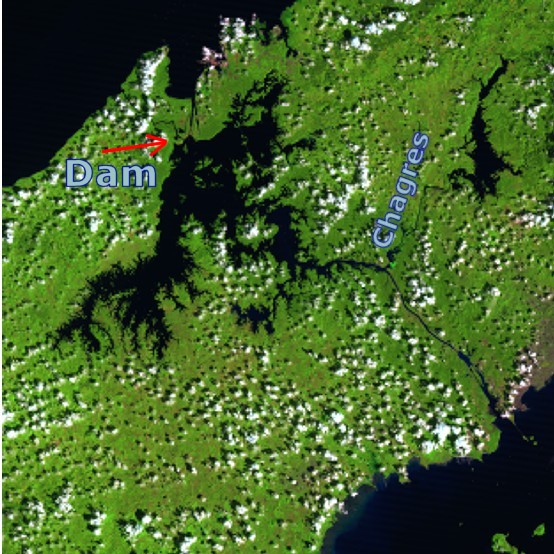 |
Although early U.S. developers
rejected this plan (including John Wallace, the first U.S.
Panama engineer), when John Frank Stevens studied it, he liked it.
De Lépinay had
pointed out that locks are the best way to carry a waterway
over uneven terrain by raising and lowering the water level
in a series of step-like chambers. A canal without
locks simply carves through the terrain -- maintaining the
same water level from start to finish. The French plan
called for making the Culebra Cut all the way down to sea
level. That was solid rock! Although the French
eventually realized it's extremely difficult a cut through
solid rock, they abandoned the plan too late to
save the effort from failure. De Lepinay suggested it
wasn't too late to learn from this failure. His plan
only required the Culebra Cut to come down to 42 feet above
sea level. That would save countless years of
difficult digging.
John Franks Stevens
studied the problem and came to his own conclusion. He completely disagreed with the
original French sea-level approach to building
the Canal. Yes, on paper, it would undoubtedly work to dig down
and deepen the canal until the waters of the Pacific and the Caribbean
would become level, but it simply wasn't practical. Stevens sensed
the sea level plan would only be accomplished at a cost no
one would be willing to pay. It is probably impossible to
conceive exactly how much work this extra digging would be, but
hindsight estimates say
the incredible amount of excavation necessary would have
expanded the project two, maybe three, maybe even four times beyond the effort that was
ultimately expended by the U.S. laborers.
The main reason
everyone favored the sea level plan was the uncertainty
surrounding the lock proposal. The sea level system
had a well-proven track record. The Suez Canal was an
ongoing miracle that worked efficiently and required little
upkeep.
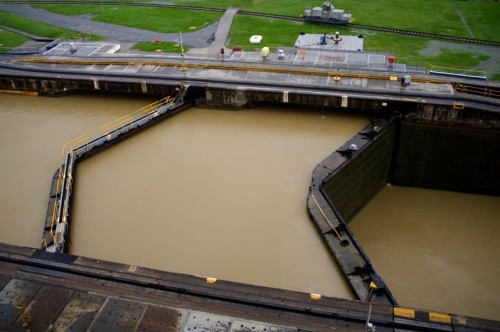 |
Stevens' system of "locks" would be complicated
and "new". The locks meant less work, but would they function
correctly? That was the big
question. No one wanted to take the risk. If the
lock system failed, they would be branded for life as the
idiot who suggested these contraptions.
Stevens discussed it with several of
America's leading "lock engineers". They all assured
him the locks would work. Stevens made up his mind...
he would only take the job if he could design a locks and
lake system.
Stevens
carefully explained to Theodore Roosevelt the feasibility
of an above sea-level canal built with dams and locks.
Stevens explained how he would dam the Chagres and create an
artificial lake.
Roosevelt was
not only persuaded, he was impressed. Stevens was
quietly brilliant. He gave Stevens permission to
do it his way. Stevens was hired just three days after
Wallace had been fired.
|
When word of
Wallace's dismissal and the
change of plan reached the press, not
surprisingly, Stevens' decision to reverse Wallace came up against a tremendous amount of opposition.
"It'll never work!" "Stick to the tried and true!"
The critics sounded just like the naysayers from Ayn Rand's
novel "The Fountainhead", a book which celebrated individual
vision over an establishment preoccupied with worship of
tradition. 'You should build it the usual way because
the usual way is usually right!'
You have to
admire the man. Against all the predictions of doom
and disaster from the experts, Stevens stuck to his guns.
They were going to do it his way. Of course, de
Lesseps had said the same thing. Stevens was well
aware a lot was riding on him being right.
Stevens to the Rescue
Amidst all the
controversy, John Frank
Stevens arrived in Panama in 1905 as the second Chief
Engineer. Stevens was immediately taken aback by the
terrible morale and living conditions. On the spot, Stevens
decided the project needed to take care of the people first
and foremost. He would get to the
engineering effort second.
With confidence and morale
desperately low among the workers, one of Stevens' first
actions was to introduce a food car. Then he created a
social hall for
entertainment. Next he began improvements in housing.
The kind of hard work that
needed done, Steven reasoned, could only be done by a
well-housed, well-fed labor force that was free of disease. Stevens
began work not by not digging, but by cleaning. The
digging could wait.
"The digging," Stevens said, "was the least thing of all."
That would become one of his favorite slogans.
Stevens wasted
no time tackling the disease problem. Stevens was the
first high-ranking official who ever took the threat of
the yellow fever-carrying mosquitoes seriously.
Stevens made a
point to sit down with Dr. Gorgas, chief medical official. Six years
earlier Dr. William Gorgas had
been part of the effort to eradicate yellow fever in Havana,
Cuba. His time there made him keenly aware of the dangers
the mosquitoes presented.
Gorgas had been an understudy of Dr. Walter Reed. Reed and Gorgas
were serving
with the U.S. Army in Cuba after the conclusion of the 1898
Spanish-American War.
When Americans
began getting sick in Cuba, Reed studied the work of Cuban
physician Carlos Finlay. Cuba had long suffered with the
same malaria and yellow fever problems as Panama.
|
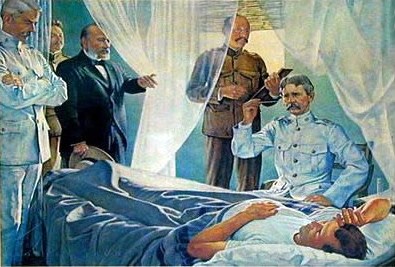 |
In 1881 Dr. Finlay
had finally solved the mystery of how these diseases spread.
He identified the mosquito as the
disease spreading agent. During his stay in Cuba, Dr. Walter Reed was able to
confirm Finlay's investigative work and passed his findings
onto Dr. Gorgas.
That had been Cuba.
Now Gorgas was saddled with the task of protecting the American
workers in Panama.
Surprised that
someone was finally willing to listen to him, Gorgas quickly
recommended the workers be immunized against yellow fever.
Good move. The last case of yellow fever was reported
in November 1905, shortly after Stevens' arrival. It
was that simple, but no one had ever bothered to care
before. What Stevens lacked in formal education, he
made up for with decency and a natural ability to go straight to
the heart of problems.
Stevens also
asked Gorgas about the malaria problem. Gorgas explained to
Stevens that it was impossible to immunize against malaria.
However, that didn't mean they were helpless. Getting rid of the mosquitoes
was the trick. Gorgas recommended
several sanitation efforts. Stevens listened to Gorgas's suggestions and heeded his advice.
Stevens made sure to build proper housing with screens for canal
workers. He oversaw investment in extensive sanitation and
mosquito-abatement programs that minimized the spread of the deadly
mosquito-spread diseases. Workers
drained swamps, swept drainage ditches, paved the muddy roads and installed
plumbing. They sprayed pesticides by the ton.
The measures did not
make the malaria go away. After all, there was a vast jungle
just outside the living quarters. However, they did reduce the
mosquito threat dramatically.
Over the course of ten years, 5,600 men would die from malaria, but
that rate was nothing compared to the French experience. Even better,
more men recovered from malaria than died from it. Most of the
fear disappeared. Working together, Gorgas and Stevens had
accomplished a
miracle.
Stevens didn't
stop there. He continued to improve the quality of life
for the men. Entire towns rose from the jungle,
complete with clean housing, schools, churches, commissaries,
and social halls.
With sanitation efforts
complete, adequate housing built, and his workers' welfare on the mend, Stevens
was ready for the next step.
Stevens was a railroad
guy, so his next move was to rebuild
the Panama Railway completely to his liking. For one thing,
parts of the old railway would have to be submerged when the Chagres Valley
was flooded to create Lake Gatun. The time to build the new
railway was now. The Railway
would allow the engineers to whisk the equipment rapidly to
any part of the canal that needed it. That enabled
them to get by with less equipment. Stevens used the
savings to purchase modern earth-moving and excavating
equipment. Just as important, Stevens developed a
rail-based system for disposing of the soil from the
excavations.
With the railway
completed, Stevens began work on a scale
never before witnessed. Gigantic Bucyrus steam shovels scooped
tons of earth from the Big Ditch. Soon railroad cars ran continuously on a double track,
dumping the tailings to form the Chagres Dam that would one
day create the Big Bathtub, aka Lake Gatun. Things worked like
clockwork under Stevens. Dig, put the dirt on the train, take
it to the dam, come back for more.
The men
respected Stevens immensely. His concern for their
welfare impressed them greatly. His humbleness and
lack of airs impressed them as well. Lacking the advanced
degrees of many of his colleagues, Stevens shunned any special
treatment as an officer. Stevens could have cared less about
comfort. The attractive living quarters used by his
predecessor remained empty as Stevens bunked nearer to
the workers.
This
hard-working, no-nonsense man had come to Panama at a time
when the project seemed doomed to the same failure that had
haunted the French. Stevens had turned the entire
project around and gotten it on track.
In November, 1906, Roosevelt himself visited the canal.
Roosevelt was amazed by the difference. He posed
proudly at
the controls of a giant Bucyrus shovel. He left Panama with a
smile on his face. Thanks to Stevens, now it seemed that the project could
not fail.
A Punch
to the Gut
Then came the blow.
Out of nowhere Chief Engineer Stevens abruptly resigned. It was February
12, 1907.
A pall came over the
camp. Just like that, their highly-respected leader was gone.
Stevens gave no explanation. He simply said it was time to go.
Stevens meant what he said. He left the next day.
Everyone was dumbfounded. No one had a clue what Stevens was
upset about or what his reason was for leaving. A huge cloud
of depression fell over the men. They had the wind knocked out
of them.
When he got the bad
news, Roosevelt was fit to be
tied. He had gone way out on a limb hiring a man with zero
experience at building canals. He had taken a lot of
heat for allowing Stevens to try his risky lock-based Canal.
The critics had a field day with that one.
Roosevelt took more political heat
when he justified Stevens' decision to concentrate on the
infrastructure. 'Build first, dig later' might make sense to
the insiders, but the American public was clamoring for results.
Now just as the focus of
the work had finally turned to construction of the canal
itself, his hand-picked man had just thrown in the towel.
The work had come to a disheartening slowdown until Stevens
could be replaced.
It was a shame to lose
Stevens because he was such an effective administrator. The
true reasons for his resignation were never revealed.
Burn-out, of course, was the most likely explanation. Another
theory was that since the time had come to work on the locks,
Stevens may have bowed out to let a man with more
experience in lock-building take over. Still, most
professionals
allow time for the new man to come aboard and get acclimated.
The abruptness of Stevens departure hinted at exhaustion... or maybe
something worse.
Now people began to
wonder. All sorts of paranoid theories were suggested.
Was he sick? Did Stevens suddenly realize the lock-based
system had no chance of working? Was he leaving to avoid shame
of some sort?
Whatever the reason, it
didn't matter. Stevens was gone. The loss affected
Roosevelt terribly. Roosevelt had let his guard down.
And why not? It seemed like the project was out of danger.
But now just when the project seemed to be in the clear, it was in serious trouble again.
Roosevelt frowned.
He wondered if there really was a curse over this canal project as
some people suggested. Maybe he didn't need another engineer.
Maybe what he needed was a witch doctor.
Stevens'
departure could not have come at a worse time. The
American public was fed up with the apparent lack of
progress. They didn't understand why Stevens had been
on the job for almost three years without doing any digging at
all. Roosevelt's opponents took the mysterious
resignation as a sign that Stevens had decided the canal
project was doomed to failure. Maybe Stevens had
discovered the locks system
wouldn't work. Maybe the machinery wasn't up to the
task of all the necessary digging. Something had to be
wrong!!
There had to be
a reason why all the work had come to a grinding halt.
Something fishy was going on in Panama. Roosevelt
faced a rising crescendo of public dissent over this
apparent boondoggle. Roosevelt frowned.
Something had to be done.
He turned to an old
friend, Joseph Bishop. Bishop was no witch doctor, but he was
a newspaperman. Roosevelt sighed. Close enough.
|
Joseph Bishop
President
Roosevelt wasn't sure just why Stevens had resigned, but he
wasn't about to admit defeat. Roosevelt calmed himself
with the realization that Stevens had left the project in
pretty good shape. Maybe the job was just too big for
one man. Surely someone else could step in.
Roosevelt saw
this crisis less as an engineering problem and more as a public
relations problem. The most
important thing was to calm down the American citizens and
his political rivals. He understood that
Stevens' "do the infrastructure first" approach would not
produce instant results, but he also could see why the
American people had grown so impatient.
Roosevelt was certain he could find someone else to do the
digging, but what could he do to reverse the burgeoning groundswell of
negative public opinion?
Joseph Bishop
was a newspaper man who had apprenticed under the legendary
Horace Greeley ("Go West, young man"). Roosevelt and Bishop first crossed
paths in 1885 when Roosevelt was cleaning up corruption in
New York City as the Police Commissioner. Faced with
many enemies, Roosevelt welcomed the unsolicited editorial
support he received from Bishop at the Evening Post.
The two men began a correspondence that would number more
than 600 letters over 25 years.
|
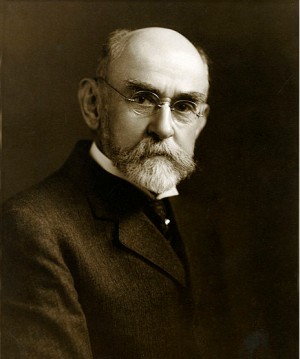 |
As their friendship developed, Roosevelt declared
to Bishop, “What I
value in you is that you give me the advice you think I need
rather than the advice you think I’d like to have.”
Stevens'
resignation had created a crisis for the Panama Project.
Roosevelt turned to Joseph Bishop for help. Officially
Bishop was appointed as Roosevelt's "Panama overseer".
However, Bishop's unspoken role was to serve primarily a
public relations job. It would be up to Bishop to
"sell" the project to the American people.
Bishop
immediately became a lightning rod for criticism.
Apparently Roosevelt gave him a very good salary which led
to charges of cronyism. Bishop’s promised $10,000
annual salary was relentlessly criticized by Roosevelt’s
opponents in Congress, mostly because it was twice what each
of them made. Opposition newspapers joined in the criticism.
When they
weren't needling Bishop about his salary, the critics
peppered him at every turn to explain why Stevens had quit
and why work on the Canal was off to such a slow start.
There was so much animosity directed at Bishop during the slow
buildup that finally in 1907 he decided to get out of town
for his own sanity. Bishop left
Washington and moved to Panama to see first-hand what the
situation was.
Bishop expected to go there for a quick look-see
and come home, but Bishop soon realized
just how much he was needed in Panama. Bishop would remain
on the isthmus for the next seven years. During that time
Bishop served clandestinely as Theodore Roosevelt’s “eyes
and ears”.
Not long after Bishop
arrived, he reported back to Roosevelt on the
“astonishing progress” that the Army Corps of Engineers were
making excavating the “big ditch” and building dams and
locks. Roosevelt was immensely relieved. Maybe
there was some hope after all.
|
George Washington Goethals
Colonel George
Washington Goethals was the man chosen replaced the
brilliant John Frank Stevens in 1907. Stevens had
rescued the project from defeat only to run out of steam.
Fortunately the project would not skip a beat.
Goethals was very talented in his own right. Goethals
had graduated second in his class from West Point. Rather
than enter the military wing of the academy, Goethals
preferred to join the Army Corps of Engineers.
In 1891 Goethals
was placed in charge of the completion of the Muscle Shoals
Canal along the Tennessee River near Florence, Alabama. This
was his first independent command. His responsibilities
included the design and construction of the Riverton Lock at
Colbert Shoals.
Goethals's
recommendation of a single lock with an unprecedented lift
of 26 feet was initially opposed by his superiors in
Washington. He was forced to persuade the conservative
army engineers of the merits of his design. The successful construction of the lock
not only set a world record for lock height at the time, it
would help him land the Panama job 15 years later.
The success of
the Riverton Lock inspired the eventual adoption of
high-lift locks elsewhere and played a key role in Goethals'
selection as Stevens' replacement. His
experience would be needed since the proposed Pedro Miguel
Lock at Panama was 31 feet. Goethals was appointed to
be Stevens' replacement by William Taft, Roosevelt's
Secretary of War and right-hand man.
|
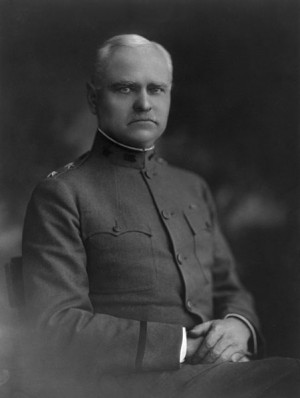 |
Goethals took
over from Stevens in 1907. It didn't take Goethals
long to guess why his predecessor had burned out.
Goethals immediately faced a veritable mountain of problems.
Goethals could barely get anything done because he was
overwhelmed by the worst morale he had ever encountered.
It seemed like he spent his entire day listening to
complaints. Goethals was an engineer, not a guidance
counselor. He was a demanding, rigidly organized
person who
hated these interruptions. Goethals fretted that valuable
details were being overlooked because he was so distracted
with personnel issues.
When Joseph
Bishop arrived out of the blue from Washington a couple
months later, Goethals was suspicious. He assumed Bishop had been sent as
Roosevelt's spy to evaluate his competence. Goethals
morbidly assumed he was about to be canned.
Goethals was correct
about one thing. Bishop was indeed there to report back
to Roosevelt. However, to Goethals' surprise, he discovered
from an inside source that Bishop had actually been very high in his
initial
praise of Goethals' work. Goethals was relieved.
At least someone believed in him.
Grateful for the
support, Goethals began to trust Bishop. They struck
up a friendship. Bishop was no engineer, but told
Goethals he was willing to help in any way he could.
That is when Goethals had an inspiration. He had just
the job for the newspaper man.
Goethals said he was being
distracted an inordinate amount of time by all the labor
complaints. Interruptions were forcing Goethals to
constantly put on hold what was important to go put out fires
instead. This left him unable to attend to the
details of the excavation process.
He asked Bishop
to assume charge of handling all the complaints from the
workers. Bishop became Goethals’s trusted aide,
serving as his first line of defense against the workers and
supervisors with their endless complaints and grievances.
Bishop solved
the morale problem in a very unique way. His greatest
achievement in Panama would be to create "The Canal Record",
a weekly newspaper he edited for the thousands of workers in
Panama. Bishop used his newspaper in an ingenious way.
He shined the spotlight on a different man each week. His
praise of the lowliest workers helped to lift spirits.
Another feature was to report the cubic yards dug by each
division. Bishop saw this as dry stuff indeed, but
amazingly the rival work divisions took the statistics
seriously. They compared their work to
the other divisions and outdid themselves to improve their
standing. Bishop had accidently helped to develop a
sense of competition.
Once Bishop saw
what was happening, he took it one step further. He
had each division form its own baseball team and started a
baseball league. Why not have a little fun for a
change? Let the Big Ditch team play the Big Bathtub
team. The baseball games created a spirit
of healthy competition that lifted worker morale and
productivity even further.
Pretty soon the
men began to develop a can-do attitude. A type of team
unity began to form. Many of the individuals began to
see themselves as a cog in a great project. Despite
the threat of disease, the danger of injury and the tedious
hard work, the constant complaining miraculously began to
diminish. People started to get along and cooperate
for a change.
This was a
turning point. Bishop had the sense to report this
“good news” back to the media in the States. His
positive reports helped to build vital public support on
newspaper editorial pages back home. The Senators and
Representatives saw the tide turning and had the sense to
get on the bandwagon while they still could. Soon the United States Congress began to rubber stamp
the massive annual appropriations required to keep the canal
project moving forward.
It took 10 years and over $380
million to complete - the most expensive
project since the Pyramids - but amazingly
Goethals
finished the Panama Canal a full two years ahead of time.
Naturally Goethals was given a great deal of much-deserved
credit, but Roosevelt knew the inside story. He was
well aware that his friend Joseph Bishop deserved just
as much credit for the turnaround as Goethals, the talented
engineer. Together these two men were quite a team.
The Panama Canal
would become intricately linked with Roosevelt's legacy and
make him famous. Roosevelt, of course, was one of the
great self-promoters of all time. He didn't mind at
all the praise
that was bestowed on him once the world discovered
what a miracle the Panama Canal was.
But Roosevelt
was also grateful. Roosevelt would later reflect
that maybe his friend Bishop deserved a lot more credit than
he had been given. Joseph Bishop was the unsung hero
of the Panama Canal project.
|
The
Panama Canal
Opens
The Panama Canal took ten years, $382 million and
several
miracles to complete.
Where the French Connection had failed, the
Americans had succeeded.
It is fair to say the
Panama Canal was built against all odds. The project succeeded
despite much doubt as to which design to use, despite constant
changes in leadership, despite fierce political opposition, and
despite the ever-present danger of disease.
No matter what went
wrong, work did go on. Despite lethal landslides,
leaders failing and leaders quitting,
men dying
and arduous working conditions, workers with
dynamite and clumsy steam shovels cut their way
through solid rock to allow water to cross a
continent.
|
It was coined the
"Greatest Shortcut in the World". The U.S. had built a railroad, three sets of concrete
locks, a massive dam and a huge artificial lake
that would allow over 13,000 ships
per year to shorten their voyages
by 8,000 miles.
The Panama Canal officially
opened on August 15, 1914, under the slogan "A Land Divided, a World
United".
Ten years after the Americans assumed
control, the
freighter Ancon entered the new channel.
Hundreds of
construction workers hopped aboard for the historic ride. A
shiny towing locomotive pulled the Ancon into the first
lock. Bands played and crowds cheered as the ship slipped
from the Pacific
into the Canal.
The newspapers relegated
Panama to their back pages and the world scarcely noticed. The
ceremony was unusually anti-climatic because German troops were driving across Belgium toward
Paris.
The greatest engineering project in the history of the world had
been dwarfed by the frightening onset of World War I.
Among the men absent from the Panama Canal's opening ceremonies were
Woodrow Wilson, President; John Stevens, the Americans' second
Chief Engineer; William Gorgas, the man who vanquished yellow fever on the
Isthmus; as well as David Gaillard of Culebra Cut fame.
Even Theodore Roosevelt,
the man most responsible for bringing the canal project to fruition,
was missing.
And where was Roosevelt?
Typical of Roosevelt, he was busy on a dangerous jungle expedition
down in South America. He was there to map some of the waters deep
inside the continent.
|
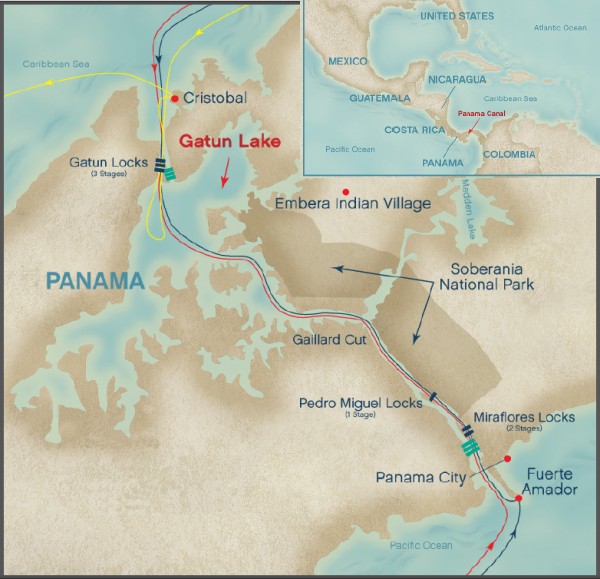 |
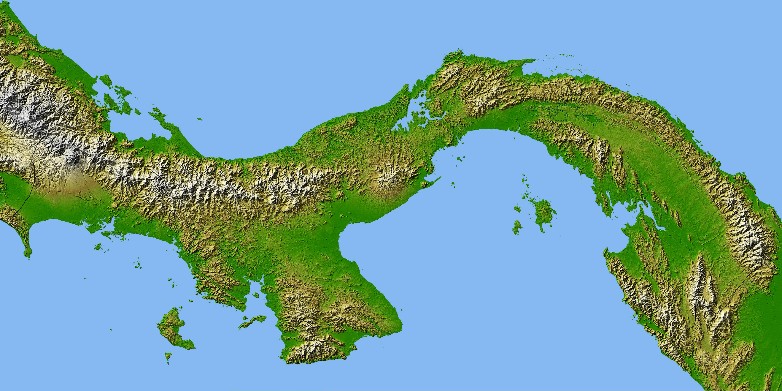 |
There were no French dignitaries at the opening of the
Panama Canal. Ferdinand de Lesseps had died twenty
years ago, taking his disgrace to his grave. I see de
Lesseps as the tragic hero of this story.
A man of great
vision and charm, he was cursed with a fatal flaw - he
didn't like to listen to people who disagreed with him.
And yet
Roosevelt received his fair share of criticism, negativity,
and contradictory advice as well. In politics, you
have to develop a thick skin or you perish.
Sometimes there
is no clear path or direction to take. Roosevelt
seemed to be better at listening to people who didn't agree
with him than de Lesseps.
|
Curiously, Roosevelt is
credited with one of the most famous quotes concerning "criticism"
ever recorded. Known as "The Man in the Arena", the following words
were spoken by Theodore Roosevelt
in a speech at the Sorbonne in Paris,
France, on April 23, 1910.
"It is not the critic who counts, not
the man who points out how the strong man stumbled, or where the
doer of deeds could have done them better.
The credit belongs to the man who is
actually in the arena; whose face is marred by dust and sweat
and blood; who strives valiantly, who errs and comes short again
and again; who knows the great enthusiasms, the great devotions,
and spends himself in a worthy cause; who, at the best, knows in
the end the triumph of high achievement; and who, at the worst,
if he fails, at least fails while daring greatly, so that his
place shall never be with those cold and timid souls who know
neither victory nor defeat."
We can only wonder if
those words would have been of any solace to Monsieur de Lesseps,
the man who dared greatly at Panama, but failed miserably.
Somehow I doubt it.
It is easy to criticize
the French, but knowing Roosevelt, he was probably grateful to the
French. Who
knows if the Americans would have succeeded had the French not tried
first? The old saying is you can tell the pioneers by the
arrows in their backs. Or who crossed the mine field first by
their dead bodies. One of the most famous French scientists in
history, Madame Curie, won two Nobel Prizes while studying
radiation. What is not well known is that this brave and
gifted woman died of radiation poisoning as the result of her
research.
It is the human
condition that we explore and take chances. That is how humans
advance as a species. Therefore we need dreamers and
visionaries such as Ferdinand de Lesseps to get giant projects off
the ground that few people had the ability to pursue. Yes, de
Lesseps failed, but would the Panama Canal have been built without
his first initiative?
The Americans benefitted greatly from the
ill-fated French attempt. Not only did the French
dig out 11 miles of the eventual 50, the Americans were warned of
all the dangers. The
thorough approach to disease control on the part of Dr. Gorgas was
the direct result of seeing the horror of yellow fever and malaria
ahead of time.
I think the
Americans should appreciate that although the French tried and
failed, they gave the USA a much better chance in so doing. The
Americans climbed on the shoulders of the French and leapt forward
to ultimate success.
Therefore I say we
should
toast the French for their valiant effort. Vive la France!
Merci beaucoup, Monsieur de Lesseps. May you rest in
peace... you certainly tried as hard as you possibly could.
You may have failed, but at least you failed while daring
greatly.
Let me add one more
thing - I cannot help but wonder if Roosevelt had de Lesseps in mind
when he wrote that speech. Considering the speech was given in
Paris while the Canal was still under construction, it almost feels
like Roosevelt is trying to console the man who died trying to
connect the Continents.
Credit
for the Panama Canal
Without a doubt,
Theodore Roosevelt deserves the most credit. Through
sheer willpower, he got the project going again in 1902.
Through determination, he kept the critics at bay even when
the project got off to a terrible start. He had the
sense to fire John Wallace - who had impeccable credentials,
but was a loser. He had the sense to hire John Frank
Stevens - who had few credentials, but talent in abundance.
In addition,
Roosevelt had the wisdom to ask an old friend - Joseph
Bishop, the unsung hero of our story - to help with the
public relations.
Another man who
deserves a lot of credit was barely mentioned in our story.
Of the three presidents whose terms coincided with Canal
construction – Roosevelt, Howard Taft and Woodrow Wilson –
it was Taft who provided the most active, hands-on
participation over the longest period. Taft visited Panama
five times as Roosevelt’s Secretary of War and made two more
trips while President. Taft was responsible for finding John
Stevens and, when Stevens resigned, recommending G. W.
Goethals.
George
Washington Goethals is the man who spent the final seven
years completing the project. Colonel Goethals
received unstinted praise from visiting engineers and from
the technical press of the world. For the rest of his
life, Goethals work, both technical and administrative, won
him an unending series of professional tributes.
In a world full of criticism, Goethals seems to have had no
critics. He did a fantastic job.
|
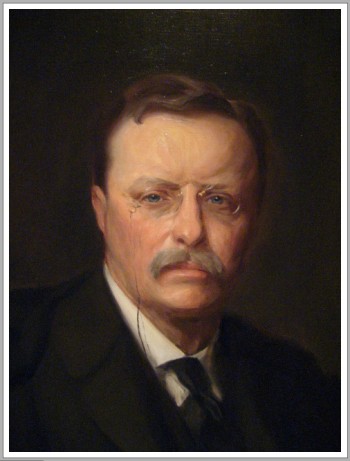 |
And yet while the meticulous
engineer George Washington Goethals probably deserved more credit than anyone for the
masterfully completed canal, he himself publicly turned away acclaim.
"The real builder of the
Panama Canal," Chief Engineer Goethals said, "was Theodore
Roosevelt."
Goethals also had very
kind words for someone else.
The biggest hero of all
might be John Frank Stevens, the unorthodox mystery man who rescued
the project from near-certain collapse in 1905.
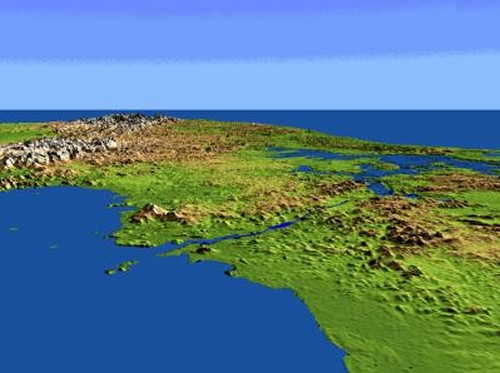 |
Stevens was
quite the enigma. Stevens lived for 36 more years
after quitting in 1907. In that time, he constantly received
accolades for his contributions to engineering.
Invariably, he was asked time and again why he left the job
in such an abrupt manner. It was obvious that he was
brilliant in so many ways. Why did he quit? What
were his reasons?
But Stevens never said a word!! He refused to talk
about it. Not even a hint. In some ways,
theories about his departure had people just as curious and
just as baffled as the riddle of who shot JFK confounds us
today.
Despite all the numerous
honors Stevens received, nothing ever compared to his send-off from the in-progress
Panama Canal in 1907. One historian noted: "As Stevens got on
the train to leave, it was as if the people
were honoring a man who had already built the Panama Canal."
Our final word
goes to G. W. Goethals, the man who took Stevens' place.
In a letter to his son, Colonel Goethals wrote,
"Mr. Stevens
has perfected such an organization ... that there is
nothing left for us to do but just have the organization
continue in the good work it has done and is doing ...
Mr. Stevens has done an amount of work for which he will
never get any credit, or, if he gets any, will not get
enough."
|
Rick Archer
October 2011
rick@ssqq.com
|
|